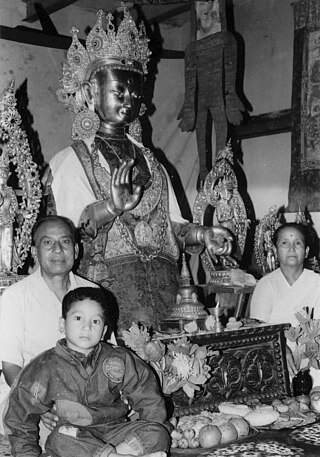
Buddhism in Nepal started spreading since the reign of Ashoka through Indian and Tibetan missionaries. The Kiratas were the first people in Nepal who embraced the Buddha’s teachings, followed by the Licchavis and Newar people. Buddhism is Nepal's second-largest religion, with 8.2% of the country's population, or approximately 2.4 million people, identifying as adherents of Buddhism in a 2021 census.

The Newar language of Nepal has the fourth oldest literature tradition among the Sino-Tibetan languages.

Tulādhar is a Nepali/Nepalese caste from the Newar community of the Kathmandu Valley in Nepal. The name Tuladhar is derived from the Sanskrit words "tula" and "dhar" (possessor), thus meaning scale-bearer or in general, merchant. Tuladhars belong to the Uray group which includes Kansakar, Tamrakar, Sthapit, Bania, Sindurakar, Selalik and other castes. They follow Newar Buddhism and speak Nepal Bhasa as a mother tongue.

Nepal Bhasa movement refers to the struggle for linguistic rights by Newar speakers in Nepal in the face of opposition from the government and hostile neighbors. The campaign aims to increase the use of Nepal Bhasa in the home, education, government and business. Despite a high level of development, Newar culture and language are both under threat.

Dharma Man Tuladhar was a Nepalese trader and philanthropist best known for the renovation of the Swayambhu stupa in Kathmandu, one of the holiest Buddhist shrines in Nepal.

Dhammalok Mahasthavir was a Nepalese Buddhist monk who worked to revive Theravada Buddhism in Nepal in the 1930s and 1940s. For this act, he was expelled from the country by the tyrannical Rana regime.

Rajguru Aggavamsa Mahathera was one of the delegates from Bangladesh) in the Sixth Buddhist council held in Yangon, Burma in 1956.

Pushpa Ratna Sagar was a Nepalese merchant, grammarian, lexicographer and pioneer pressman. Born Pushpa Ratna Tuladhar in Asan Dhalasikwa, Kathmandu, he acquired the nickname Sagar in his childhood during a pilgrimage to Ganga Sagar in India. He was the third and youngest son of trader Pushpa Sundar Tuladhar and his wife Dhan Maya.

Dharmaditya Dharmacharya (1902–1963) was a Nepalese author, Buddhist scholar and language activist. He worked to develop Nepal Bhasa and revive Theravada Buddhism when Nepal was ruled by the Rana dynasty and both were dangerous activities, and was consequently jailed.
Dharmodaya was a monthly magazine in Nepal Bhasa on Theravada Buddhism. It was launched from Kalimpong, India, in 1947 to counter the ban on publication in Nepal.
Aniruddha Mahathera was a Nepalese Buddhist monk and the Sangha Nayak (Patriarch) of Nepal from 1998 until his death in 2003. He was one of the most important figures in the revival of Theravada Buddhism in Nepal and the development of Lumbini, the Buddha's birthplace in southern Nepal, into a center of international pilgrimage.

Pragyananda Mahasthavir was a Nepalese Buddhist monk who was one of the leaders of the revival of Theravada Buddhism in Nepal. In 1930, he became the first monk wearing yellow robes to be seen in Kathmandu since the 14th century.

Bauddha Rishi Mahapragya was one of the most influential figures in the revival of Theravada Buddhism in Nepal in the 1920s. In 1926, he was jailed and then exiled by the tyrannical Rana regime for converting to Buddhism from Hinduism.

Buddhaghosa Mahasthavir was a Nepalese Buddhist monk who worked to revive Theravada Buddhism in Nepal in the 1940s in the face of suppression by the Rana regime.

Dharmachāri Gurumā was a Nepalese anagarika who was an influential figure in the revival of Theravada Buddhism in Nepal. She was expelled from Kathmandu by the government for her religious activities.

Sudarshan Mahasthavir (1938–2002) was a Nepalese Buddhist monk and author who played a major role in the development of Theravada Buddhism in Nepal and Nepal Bhasa literature. He was jailed by Nepal's repressive Panchayat regime for his activities supporting language rights.

The banishment of Buddhist monks from Nepal was part of a campaign by the Rana government to suppress the resurgence of Theravada Buddhism in Nepal in the early the 20th century. There were two deportations of monks from Kathmandu, in 1926 and 1944.

Pranidhipurna Mahavihar is a Theravada Buddhist monastery in Balambu, Kathmandu which was a key base in the revival of Theravada Buddhism in Nepal in the 1940s.

Kindo Baha, also known as Kinnu Bāhā, Kindol Bāhāl or Kimdol Bāhāl, is a vihara in Kathmandu which was the hub for the resurgence of Theravada Buddhism in Nepal from the 1920s to the 1940s.


















